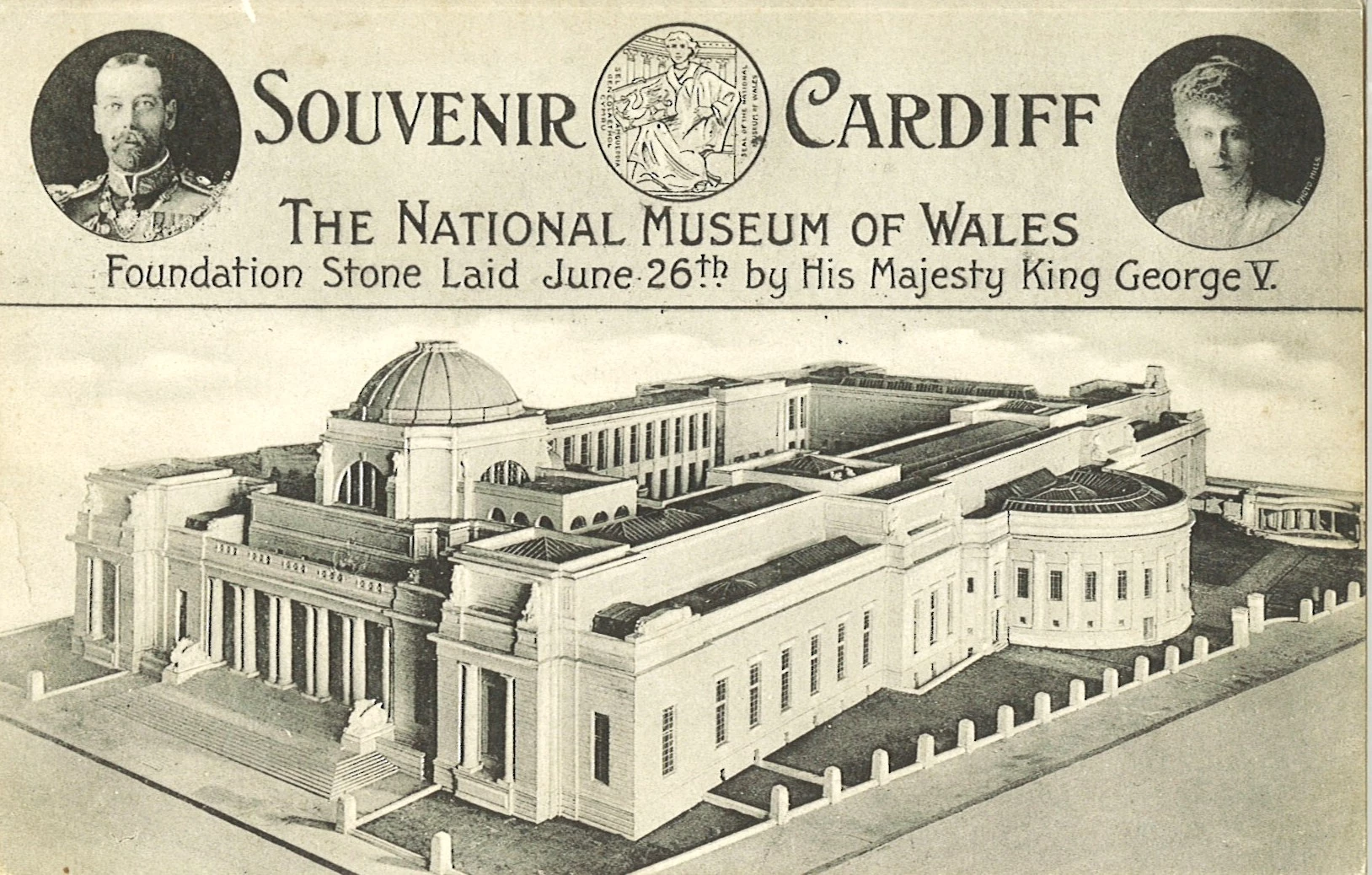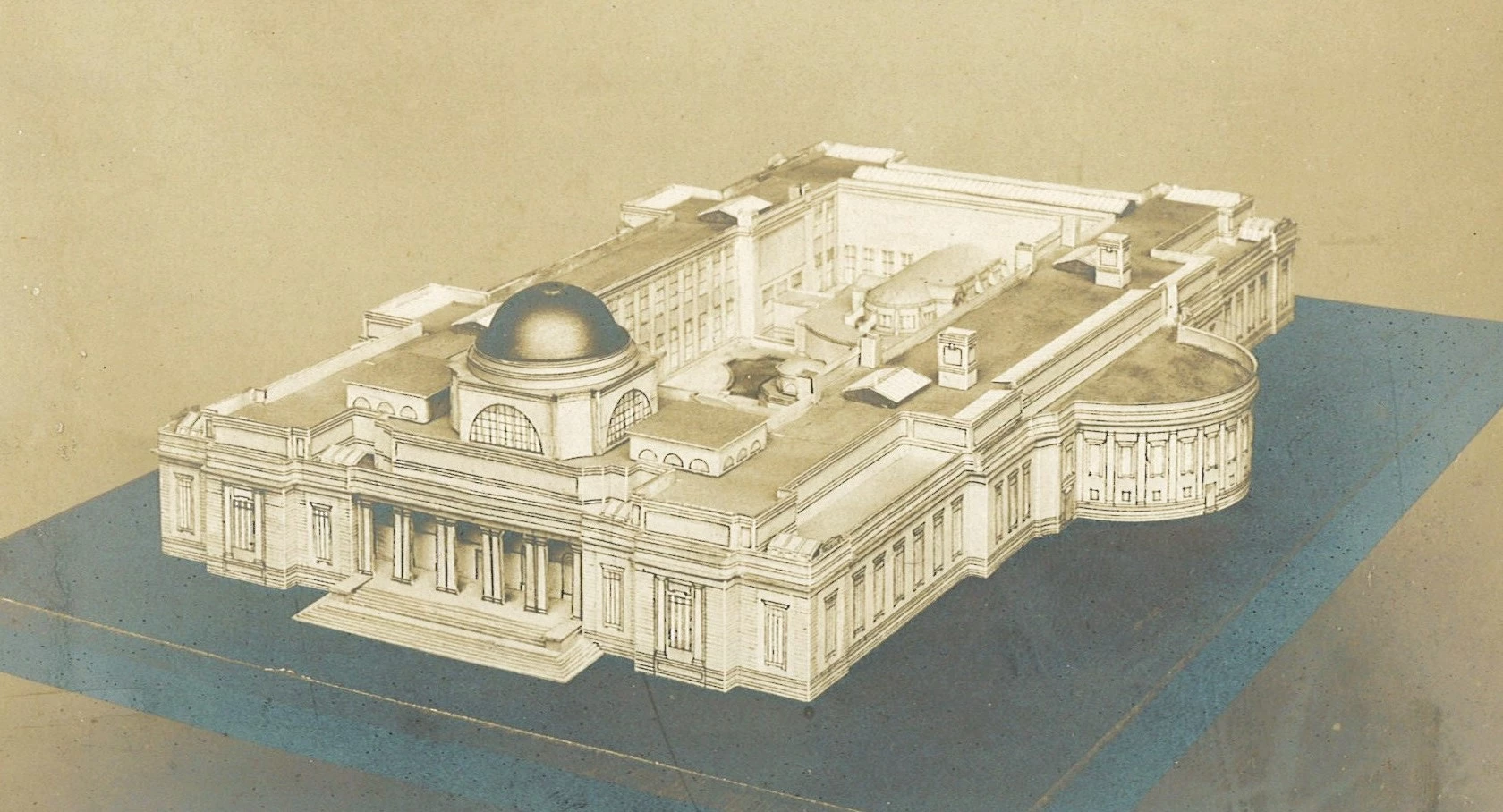Museum models
, 4 October 2021
The Museum holds three architectural models of the National Museum Cardiff building.
Four models were made but, the oldest now only exists in a faded sepia photograph, not surprising as it was a fragile paper prototype. The next oldest, the model proper and referred to in hushed tones of reverence as the “original”, is so precious [and enormous] it has been dismantled and packed away in secure, safe storage. The next model is a cool 1960s minimalist Perspex cube with playful, removable plates representing the various floors in the museum building. This is currently in the process of conservation. The fourth and final model, complete with tiny plastic figures, cars, and greenery, was created in 1988 to illustrate the museum’s Courtyard Extension by the Alex Gordon Partnership.
Founded by Royal Charter in 1907, and with location established at Cathays Park in Cardiff, the Museum set an open competition in 1909 for the building’s design. Out of 130 design submissions, the competition was won by the London based architects A. Dunbar Smith & Cecil C. Brewer. The Museum did not intend that the entire building be constructed at once and, favoured a design which would allow parts to be added as funds allowed. The foundation stone was laid by King George V and Queen Mary on 26 June 1912 and in 1913, the building of the superstructure began. As there is no mention of it in the Museum Council Minutes, we can only surmise that most likely this delicate paper model was created and presented to the Museum Council for review by Smith & Brewer.
The original model of the National Museum Wales building on display in the Main Hall in 1957
First mention of the original model appears in the Museum Council Minutes for 1November 1910 – 31 October 1911. They state that a Sub-Committee consisting of the then Chairman, Sir E. Vincent Evans, and the celebrated Welsh sculptor, W. Goscombe John was appointed to begin organising the creation of the model, with power to accept a tender of no more than £200 for its making. Further on, we learn that an estimate of £165 from a Mr. J. Lambert [of London] was accepted. The model was to be of the complete building, built of wood and to a scale of a quarter-of-an-inch to a foot. Further on there is mention that Mr Lambert was working too slowly so he was presented with a deadline for completion of 1 October 1912!
In the Minutes for 27 October 1911 to 22 October 1912, it is stated that the finished model spent two weeks during May 1912 on display in the Petition-room at Westminster Hall and in July was on view in the Temporary Museum, City Hall, Cardiff. The Temporary Museum was a construction erected in the courtyard behind City Hall and used by the Museum for exhibitions until the new building was finished and able to house the collections. It was also sent to the National Eisteddfod [held in Wrexham during 1912]. This burst of marketing and promotion illustrates the importance which was placed on it, the culmination of decades of exhaustive labour leading up to the establishment of Wales’ National Museum. Moreover, it prepared the inhabitants of Cardiff for how extensively the new Museum would physically alter the landscape of the Cathays Park area, nestling between City Hall [built in 1906] on its right and the University [opened in 1883] at its rear.
One of the best photographs of the original model was taken when it was displayed in the Main Hall fifty years later to commemorate the Museum’s Jubilee anniversary in 1957. This photo appears in the Annual Report with the caption, “The Jubilee Exhibition in the centre of the Main Hall. A model showing the museum as it will be when complete is to be seen on the left…”. This appears to be the last time the model was publicly on display.
Images of the original model were used to illustrate various postcards, including this one commemorating the Laying of the Foundation Stone in 1912
Perspex box model shown in process of conservation [images courtesy of Jennifer Griffiths, Conservator]
Now, let’s fast forward to the swinging 60s and this next model couldn’t be more different! A clear Perspex box measuring approx. 2 ft square and around 5 inches high, showing the lay-out of floors of the museum building. Commissioned by the Friends of the National Museum Wales as a gift to the Museum Schools Services in 1969 [at a cost of £173] to facilitate explaining the lay-out of the building to groups of school children.
Detail of Perspex box model of National Museum Wales building in Cathays Park shown in process of conservation [images courtesy of Jennifer Griffiths, Conservator]
Model of National Museum Wales [courtyard extension] by the Alex Gordon Partnership 1988
The staff of the Museum Schools Service often give talks to large groups of school children in which they explain the purpose and lay-out of the Museum. On these occasions it has proved difficult to give a clear idea of the location of the principal galleries to a seated audience. The new model provides an admirable aid for this purpose. It is made of clear Perspex and is constructed in such a way so that each “floor” can be re-moved separately for explanatory comments. Each Museum Department has been given a colour code to distinguish it when the model is fully assembled.
Friends of the National Museum Wales, Fifteenth Annual Report, 1969 [page 9].
The designer was Christopher Shurrock [b. 1939], British painter, printmaker, and sculptor who was at that time teaching Foundation Studies in Art at the Cardiff Institute of Higher Education. A prolific a member of the 56 Group Wales and the Royal West of England Academy, during the 1960s his interests lay in researching perception, colour and drawn structures and breaking them down to their most basic form. The model is exemplified in Shurrock’s own words ‘...superficial appearances and mechanisms can delude with too much arbitrary stuff, integral content is often fragile, co-incidence is not necessarily proof, the recurring dilemma is what really needs to be shown...’.
Our final model, as already mentioned, was created to illustrate the museum’s courtyard extension designed by the Alex Gordon Partnership in 1988.
Model of National Museum Wales by the Alex Gordon Partnership 1988 showing courtyard extension [filled-in garden area]
Sir Alexander John Gordon, CBE (1917 – 1999) was a Welsh architect who designed several major buildings in South Wales, notably the Sherman Theatre in Cardiff [1973] and the Telephone exchange extension in Swansea [1971]. He also served as President of the Royal Institute of British Architects from 1971 – 1973. His design for the ‘courtyard extension’ was so named because it involved the filling-in of the space in between the two wings that, in the original architect’s designs was to contain an exterior courtyard garden. However, it was decided instead, in the most basic of terms, to roof over the central area as you can see here.
Architect's paper model of National Museum Wales building in Cathays Park [circa 1910]
Now compare with the original paper model showing the central area open
Architect's paper model of National Museum Wales building in Cathays Park [circa 1910]
These models hold a significant place in our hearts, the earlier ones represent the culmination of the hopes and dreams of the move towards the creation of a Welsh national identity, while the later models celebrate the ever-evolving vision that epitomizes the Museum today.
We are happy to report that the spirit of model making is currently alive and well here at the museum! During lockdown Museum Assistant Jade Fox began recreating in miniature, some of the galleries at National Museum Cardiff. Take a look at this short film where she explains how she began with time on her hands and an old pizza box…



![Perspex box model of National Museum Wales building in Cathays Park shown in process of conservation, designed by Christopher Shurrock [images courtesy of Jennifer Griffiths, Conservator]](/media/52914/version-full/Perspex-box-model-images-courtesy-of-Jennifer-Griffiths-Conservator.webp)
![Detail of Perspex box model of National Museum Wales building in Cathays Park shown in process of conservation, designed by Christopher Shurrock [images courtesy of Jennifer Griffiths, Conservator]](/media/52915/version-full/Perspex-box-model-detail-images-courtesy-of-Jennifer-Griffiths-Conservator.webp)
![Model of National Museum Wales building in Cathays Park [courtyard extension] by the Alex Gordon Partnership 1988](/media/52916/version-full/Model-of-National-Museum-Wales-courtyard-extension-by-Alex-Gordon-Partnership-1988.webp)
![Model of National Museum Wales building in Cathays Park by the Alex Gordon Partnership 1988 showing courtyard extension [filled-in garden area]](/media/52917/version-full/Model-NMW-courtyard-extension-by-Alex-Gordon-Partnership-1988-6-2.webp)

Comments - (1)